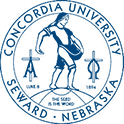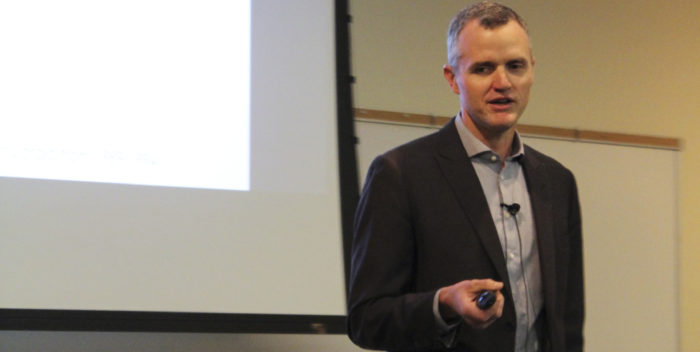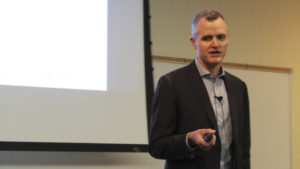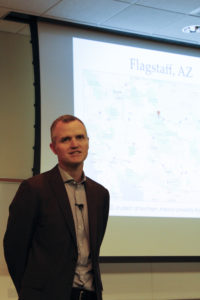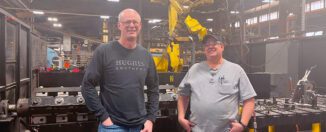Alumnus Shares Experiences Studying Bubonic Plague
by Victoria Cameron
Dr. David Wagner, a Concordia alumnus who graduated in 1994, came to campus on Oct. 10 to share how he went from Concordia to studying bubonic plague at Northern Arizona University.
Before presenting, Wagner went around campus and reminisced with Dr. Joe Gubanyi, an emeritus biology professor, who had been his teacher and advisor when he attended Concordia.
“It’s a dream for us to see former students come back and share their successes,” Gubanyi said.
Wagner’s road to success was a long one. Before coming to Concordia, Wagner had little interest in school until his senior year, when Dr. Brent Royuk began teaching physics at his high school and made the subject interesting to him.
Wagner was highly influenced by Royuk, who is now a professor of physics at Concordia, and chose to attend the college after he and other students toured the campus with Royuk. He also planned to imitate Royuk by studying secondary education for physics and math.
However, Wagner did not enjoy having to take physics and math classes five days a week and soon started skipping classes. A professor once told him in front of the class that he might as well drop out since he was going to fail anyway. This got Wagner’s attention. He promised the professor he would never miss again, and he kept that promise.
Wagner became a more dedicated student but realized he would rather work with animals than physics. He asked Gubanyi to be his advisor, and Gubanyi suggested he get field experience.
Wagner did field research that involved capturing cowbirds, and then capturing small rodents, for two summers before graduating. After graduating, he did environmental work with Americorps, but realized that he’d rather be doing research.
To be able to do this research, Wagner went to graduate school at Northern Arizona University. Again, a professor was dissatisfied with his work ethic, and Wagner realized that what the professor needed was for him to be there and working more often. He’s come to believe that these realizations are the key to having decent working relationships.
“Figure out what your boss needs from you and give it to them, and they’ll pretty much leave you alone,” Wagner said.
In Arizona, Wagner noticed an unexplained decline in prairie dog populations, and decided to research it. He discovered that they were dying of the same thing that caused the Black Death– bubonic plague.
There have been three pandemics of the Plague, and it has arguably caused more human deaths than any other infectious disease in history. The most recent pandemic, in the 19th and 20th centuries, finally ended when hygiene improved and rat populations were controlled. Plague can now be beaten with simple antibiotics.
What most people don’t realize is that bubonic plague is still around today. Plague is a disease of rodents and their fleas, and the rodent populations of the southwestern United States have been heavily affected.
Wagner researches the Plague-caused prairie dog deaths by putting together a toilet snake, an alligator clip, and white flannel, breathing heavily on the flannel to cover it in carbon dioxide, and sticking it down into prairie dog burrows to gather Plague-infected fleas. He then brings those back to the lab and studies them carefully.
“We always freeze the fleas before we work with them because our biosafety officer frowns upon us working with live Plague-infected fleas in the lab. She’s sensitive that way,” Wagner said.
By extracting DNA from Plague-infected fleas, Wagner discovered multiple genotypes of Plague in just one burrow. Previously, there had been thought to be only three strains.
Soon after this discovery, letters containing anthrax spores were sent out as a deadly attack. Wagner’s genotyping system was suddenly in demand to aid the investigation. He and his team were able to identify the strain of anthrax, which changed the nature of the investigation as to where they were looking.
This success and its importance to the investigation made Wagner’s field very popular. Fortunately, he was already in the field, unlike those who were attempting to get into it. He has advanced to be a professor at Northern Arizona University, where he continues to study the Plague.
“It was luck of the draw, the right place at the right time, but you can’t control that. You can control what you do with those opportunities,” Wagner said.
Wagner closed by pointing out that no work is done in a vacuum. He said everything he has accomplished has been a team effort and that it’s important to thank the people who work with and support you.

